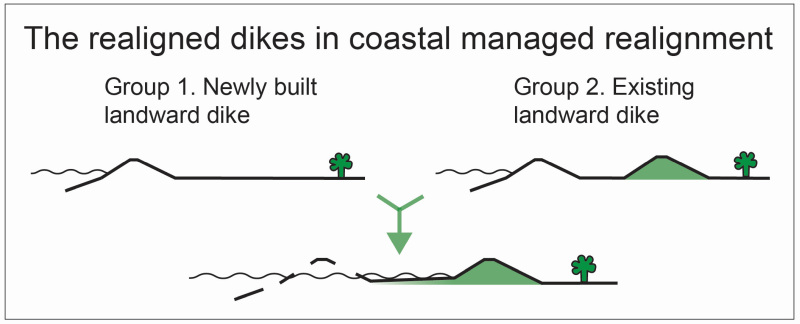K. van den Hoven1*, C. Kroeze1, J. M. van Loon-Steensma1,2
1 Wageningen University & Research; 2 Van Hall Larenstein University of Applied Sciences
*corresponding author:
Introduction
Managed realignment is the landward relocation of flood infrastructure to reintroduce the tide on former reclaimed land. Managed realignment can be seen as a way towards more diverse approaches in coastal engineering by combining flood protection by the realigned dike (artificial) and restored vegetated foreshores such as saltmarshes (nature-based). Connecting dikes and vegetated foreshores in a hybrid flood defence such as a managed realignment adds to making our coasts ready for upcoming climate change. But, are the realigned dikes ready for a connection with the restored foreshores?
Methods
We performed a literature review to characterize European realigned dikes and to indicate the characteristics that offer opportunities for connecting the dike and restored foreshore. An initial list of realignments at coastal seas and estuaries was composed using the Online Managed Realignment Guide (OMReG). This list was updated by consulting scientific literature in the database Scopus, by consulting experts, and by searching for additional and ongoing realignment projects in Google search engine.
Results
We categorized 90 European coastal managed realignment projects into two main realigned dike groups: 1) Newly built landward dikes and 2) Existing landward dikes of former multiple dike systems (Figure 1). The second group has two subcategories: 2a) Former hinterland dikes and 2b) Realignments within summer polders. From a nature-based flood protection perspective, the presence of an artificial dike is ambiguous. Our results show that targeted and expected saltmarsh restoration at managed realignments does not necessarily result in a greener realigned dike design that suits for combined flood protection with restored saltmarshes. Therefore, in further research we study how the dike revetment can be suited for a connection with the restored foreshores to form a nature-based hybrid flood defence. Pre-liminary results of our real size field experiment show that sod transplantation can provide local resources for the revetment of realigned dikes. We found that the vegetation of transplanted sods continued to grow and started to connect to the dike after one growth season. While very extreme circumstances still eroded part of the transplanted sods, the erosion resistance of the sods revetment is promising.

Figure 1: Two main groups of realigned dikes in coastal managed realignment (source: graphical abstract Van den Hoven et al. 2022).
References
Van den Hoven, K., Kroeze, C., & van Loon-Steensma, J.M. (2022). Characteristics of realigned dikes in coastal Europe: overview and opportunities for nature-based flood protection. Ocean and Coastal Management, 22, 106116. https://doi.org/10.1016/j.ocecoaman.2022.106116
I. Surname1*, F.N. Another-Surname2 , Y. Next-Surname2
1 University Name, Country; 2 Organization Name, Country
* Corresponding author: mail.name@organization.org


